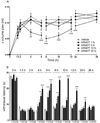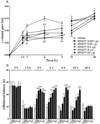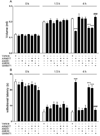Antinociceptive effects of the N-acylethanolamine acid amidase inhibitor ARN077 in rodent pain models
- PMID: 23218523
- PMCID: PMC3723234
- DOI: 10.1016/j.pain.2012.10.018
Antinociceptive effects of the N-acylethanolamine acid amidase inhibitor ARN077 in rodent pain models
Abstract
Fatty acid ethanolamides (FAEs), which include palmitoylethanolamide (PEA) and oleoylethanolamide (OEA), are endogenous agonists of peroxisome proliferator-activated receptor-α (PPAR-α) and important regulators of the inflammatory response. They are degraded in macrophages by the lysosomal cysteine amidase, N-acylethanolamine acid amidase (NAAA). Previous studies have shown that pharmacological inhibition of NAAA activity suppresses macrophage activation in vitro and causes marked anti-inflammatory effects in vivo, which is suggestive of a role for NAAA in the control of inflammation. It is still unknown, however, whether NAAA-mediated FAE deactivation might regulate pain signaling. The present study examined the effects of ARN077, a potent and selective NAAA inhibitor recently disclosed by our group, in rodent models of hyperalgesia and allodynia caused by inflammation or nerve damage. Topical administration of ARN077 attenuated, in a dose-dependent manner, heat hyperalgesia and mechanical allodynia elicited in mice by carrageenan injection or sciatic nerve ligation. The antinociceptive effects of ARN077 were prevented by the selective PPAR-α antagonist GW6471 and did not occur in PPAR-α-deficient mice. Furthermore, topical ARN077 reversed the allodynia caused by ultraviolet B radiation in rats, and this effect was blocked by pretreatment with GW6471. Sciatic nerve ligation or application of the proinflammatory phorbol ester 12-O-tetradecanoylphorbol 13-acetate decreased FAE levels in sciatic nerve and skin tissue, respectively. ARN077 reversed these biochemical effects. The results identify ARN077 as a potent inhibitor of intracellular NAAA activity, which is active in vivo by topical administration. The findings further suggest that NAAA regulates peripheral pain initiation by interrupting endogenous FAE signaling at PPAR-α.
Copyright © 2012 International Association for the Study of Pain. Published by Elsevier B.V. All rights reserved.
Conflict of interest statement
The authors have the following conflicts of interest to report: Daniele Piomelli, Andrea Duranti, Giorgio Tarzia and Marco Mor are inventors in patent applications protecting the structures and uses of NAAA inhibitors.
Figures









Comment in
-
N-acylethanolamine acid amidase (NAAA), a new path to unleash PPAR-mediated analgesia.Pain. 2013 Mar;154(3):326-327. doi: 10.1016/j.pain.2012.12.012. Epub 2012 Dec 28. Pain. 2013. PMID: 23333052 Free PMC article. No abstract available.
References
-
- Ahern GP. Activation of TRPV1 by the satiety factor oleoylethanolamide. J Biol Chem. 2003;278:30429–30434. - PubMed
-
- Armirotti A, Romeo E, Ponzano S, Mengatto L, Dionisi M, Karacsonyi C, Bertozzi F, Garau G, Tarozzo G, Reggiani A, Bandiera T, Tarzia G, Mor M, Piomelli D. β-Lactones inhibit N-1432 acylethanolamine acid amidase by S-acylation of the catalytic N-terminal cysteine. ACS. Med. Chem.Lett. 2012;3:422–426. - PMC - PubMed
-
- Bennett GJ, Xie YK. A peripheral mononeuropathy in rat that produces disorders of pain sensation like those seen in man. Pain. 1988;33:87–107. - PubMed
-
- Bisogno T, Maurelli S, Melck D, De Petrocellis L, Di Marzo V. Biosynthesis, uptake, and degradation of anandamide and palmitoylethanolamide in leukocytes. J Biol Chem. 1997;272:3315–3323. - PubMed
Publication types
MeSH terms
Substances
Grants and funding
LinkOut - more resources
Full Text Sources
Other Literature Sources
Medical
Molecular Biology Databases

